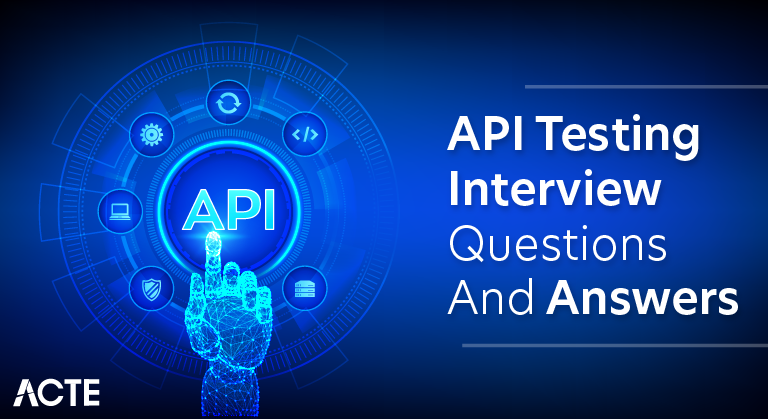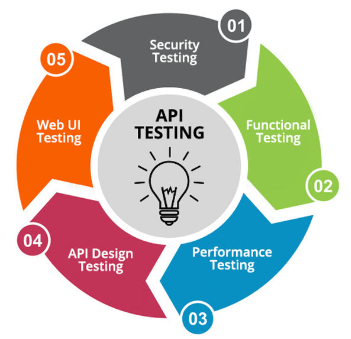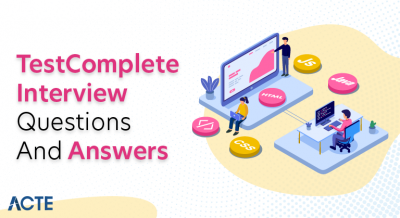
API testing is a crucial aspect of software development that involves testing the application programming interfaces (APIs) to ensure their functionality, reliability, performance, and security. Here are some key points and best practices for API testing: unit testing is used Test individual functions or methods of the API in isolation.Integration Testing is used to verify that different parts of the system work together when the API is integrated.Functional Testing ensures the API functions according to its specifications.
1. What is API testing?Ans:
API testing involves verifying the functionality, performance, and security of application programming interfaces (APIs).

Ans:
API testing is crucial for ensuring that APIs work as intended, facilitating communication between different software components and systems.
3. What are the common types of APIs?Ans:
Common types of APIs includes:
- RESTful APIs
- SOAP APIs
- WebSockets.
Ans:
| Feature | REST | SOAP | |
| Acronym |
Representative State Transfer by Acronym |
The Protocol for Simple Object | |
| Protocol | Along with TCP, SMTP, and HTTP | persists until specifically removed or invalidated, spanning several sessions and transactions. | |
| Message Format | XML or JSON is common | XML | |
| Communication Style |
Stateless,client-server communication versus stateful |
request-response communication |
Ans:
An endpoint is a specific URL or URI where an API can be accessed.
6. What is the purpose of the POST method in API testing?
Ans:
The POST method is used to send data to the server to create a new resource.
- Data Submission
- Request Payload
- Security
- State-Changing Operations
- Security Tokens
- File Uploads
Ans:
In the context of API (Application Programming Interface) responses, a status code is a three-digit numerical code included in the HTTP header of a server’s response to a client’s request. It provides a concise and standardized way for the server to communicate the outcome of the request to the client. Status codes are categorized into five classes, with each class representing a different type of response. The first digit of the status code denotes the class, while the remaining two digits offer more specific information.
8. Explain the concept of authentication in API testing.Ans:
The concept of authentication in API testing
- Token-Based Authentication
- JWT (JSON Web Tokens)
- Secure Communication
- Session Management
- Testing Authentication in API Testing
Ans:
The Authorization header contains credentials (such as tokens or API keys) to authenticate and authorise the API request as follows
- Header Purpose
- Authentication Information
- Bearer Tokens
- API Keys
- Secure Communication
Ans:
Query parameters are used to filter, sort, or customise the data returned by an API request.
11. What is the difference between PUT and PATCH methods in API testing?Ans:
The PUT method is used to update or create a resource entirely, while the PATCH method is used to partially update a resource.
12. How can you test API performance?Ans:
API performance testing is crucial to ensure that an application’s APIs meet the expected responsiveness and reliability standards. One approach is to conduct load testing, simulating various levels of concurrent user activity to assess how well the API handles increased loads.
13. How do you handle errors in API responses?Ans:
Errors in API responses are typically handled by examining the status code and response body, providing meaningful error messages.
14. What is API rate limiting?Ans:
API rate limiting restricts the number of requests a client can make within a specified time period to prevent abuse.
15. Explain the concept of mocking in API testing.Ans:
Mocking involves creating simulated versions of APIs or components to simulate specific behaviours for testing purposes.
16. What is the purpose of API documentation?
Ans:
Its primary purpose is to provide developers with clear and structured information on how to interact with the API, offering detailed explanations like:
- Endpoints
- Parameters
- Request/response formats
- Authentication methods
- Error handling.
Ans:
Swagger offers several advantages for API documentation, making it a popular choice among developers. First, Swagger provides a standardised and machine-readable format for documenting APIs, ensuring consistency and clarity in the documentation structure.
18. What is the difference between manual and automated API testing?Ans:
Manual API testing involves human testers interacting with APIs, while automated API testing involves using scripts or tools to execute tests.
19. Explain the concept of contract testing in API testing.Ans:
Contract testing ensures that the interactions between different systems (e.g., microservices) adhere to agreed-upon contracts or specifications.
20. What is the purpose of JSON Web Tokens (JWT) in API authentication?Ans:
JWT is a compact, URL-safe means of representing claims to be transferred between two parties. It is commonly used for authentication in API requests.
Ans:
Security testing for APIs is paramount to ensure the protection of sensitive data and prevent unauthorised access. One crucial aspect is implementing thorough authentication mechanisms, such as API keys, OAuth tokens, or JWTs, to verify the identity of clients interacting with the API.
23. What is the role of the Content-Type header in API requests?Ans:
The Content-Type header specifies the media type of the resource being sent or requested, such as JSON or XML.
24. Explain the concept of CORS in API testing.
Ans:
Cross-Origin Resource Sharing (CORS) is a security feature implemented in web browsers to control and restrict web page requests that originate from different domains.
25. How do you handle versioning in API development?Ans:
API versioning can be done using URL versioning (e.g., /v1/resource) or through headers, such as the Accept or Content-Type headers.
26. What is the purpose of the OPTIONS HTTP method in API testing?Ans:
- The OPTIONS HTTP method in API testing serves a critical role in supporting Cross-Origin Resource Sharing (CORS).
- It is utilised as a preflight request, allowing the web browser to check with the server whether a cross-origin request is permitted before actually making the intended request.
Ans:
Ensuring data integrity in API testing is crucial for maintaining the accuracy and reliability of information exchanged between applications.Validating request parameters, headers, and payloads guards against injection attacks and ensures that only valid data is processed.
28. What is the role of the Cache-Control header in API responses?
Ans:
The Cache-Control header provides directives for caching mechanisms in both requests and responses to control caching behaviour.
29. How do you handle sensitive information in API requests?Ans:
Sensitive information in API requests should be transmitted securely using encryption (HTTPS) and stored securely on the server. Avoid including sensitive data in URLs.
30. Explain the difference between positive and negative testing in API testingAns:
Positive testing involves validating expected behaviour, while negative testing involves intentionally testing for invalid inputs or unexpected behaviour.
31. What are the common challenges in API testing?Ans:
Common challenges in API testing includes:
- Handling authentication
- Dealing with rate limiting
- Ensuring data consistency
- Maintaining test data.
Ans:
BDD involves collaboration between developers, testers, and non-technical stakeholders to define and test the behaviour of a system in natural language terms.
33. How can you validate response data in API testing?Ans:
Response data can be validated using assertions, comparing expected values to actual values in the API response.
34. What is the purpose of the HEAD HTTP method in API testing?Ans:
The HEAD HTTP method in API testing serves the purpose of retrieving metadata about a resource without actually fetching the resource itself.
35. Explain the concept of code coverage in API testing.Ans:
- Code coverage in API testing refers to the measurement of the extent to which the source code of an application is executed during the testing process.
- It provides insights into which parts of the code are exercised by the test suite, helping assess the thoroughness of testing efforts.
Ans:
The Accept header specifies the media types that the client can understand, helping the server determine how to format the response.
37. How do you handle API version changes without breaking existing clients?Ans:
API versioning, backward compatibility, and providing detailed release notes help ensure that changes do not break existing clients.
38. What is the purpose of load testing in API testing?Ans:
Load testing assesses the performance and behaviour of an API under expected and peak loads, identifying potential bottlenecks or performance issues.
39. Explain the concept of fuzz testing in API security?Ans:
Fuzz testing, also known as fuzzing, is a dynamic security testing technique employed in API security to identify vulnerabilities and weaknesses in software by injecting unexpected, malformed, or random data into the API inputs.
40. How can you simulate network delays in API testing?Ans:
Simulating network delays is a crucial aspect of API testing to assess how an application performs under real-world networking conditions. One method to introduce delays is by utilising network emulation tools or proxy servers capable of introducing latency.
- <protocol>://<service-name>/<ResourceType>/<ResourceID>
Ans:
The Retry-After header indicates the duration the client should wait before making a follow-up request after receiving a 503 (Service Unavailable) status.
42. Explain the concept of stateless communication in RESTful APIs.Ans:
Stateless communication means that each request from a client to a server contains all the information needed to understand and fulfil that request, without relying on stored server state.
43. How do you handle pagination in API responses?Ans:
Pagination is often handled using query parameters like page and pageSize to retrieve subsets of data, and the API response includes metadata indicating the total number of pages and items.
44. What are the advantages of using tools like Postman or Insomnia for API testing?
Ans:
Tools like Postman and Insomnia provide a user-friendly interface for creating, testing, and documenting APIs, allowing testers to automate repetitive tasks and manage test collections.
45. Explain the concept of smoke testing in API testing.Ans:
Smoke testing, also known as sanity testing, involves quickly running essential test cases to determine if the API is stable and ready for more comprehensive testing.
46. How do you handle API versioning in URL paths?Ans:
API versioning in URL paths involves including the version number directly in the URL, such as /v1/resource.
47. What is the purpose of the If-Match and If-None-Match headers in API requests?Ans:
These headers are used for conditional requests, where If-Match is used to perform an action only if the resource matches the provided ETag, and If-None-Match is used to perform an action only if the resource does not match the provided ETag.
50. Explain the concept of contract-first API development.Ans:
Contract-first API development involves defining the API contract (such as OpenAPI or Swagger specifications) before implementing the actual API, ensuring that client and server teams agree on the expected behaviour.
51. What is the purpose of the X-Forwarded-For header in API requests?Ans:
The X-Forwarded-For header is used in proxy scenarios to convey the original client’s IP address, allowing the server to determine the actual source of the request.
52. How do you handle testing APIs with asynchronous operations?Ans:
Testing APIs with asynchronous operations involves waiting for the completion of asynchronous tasks, using techniques like polling or callbacks, and ensuring that the API responses correctly indicate the status of asynchronous operations.
53. What is the role of the Content-Encoding header in API responses?Ans:
The Content-Encoding header specifies the encoding transformations that have been applied to the data, such as gzip or deflate, allowing clients to decode the response.
54. How do you handle testing APIs with OAuth authentication? P?Ans:
Testing APIs with OAuth involves obtaining valid access tokens for authentication and ensuring that requests include the correct Authorization header with the token.
55. Explain the concept of stateful and stateless authentication in API testing.Ans:
Stateful authentication involves storing session information on the server, while stateless authentication relies on tokens or credentials sent with each request, without server-side storage. 56. What is the purpose of the Cross-Origin-Embedder-Policy header in API responses?
Ans:
This header is used to control whether a document can be embedded by others, mitigating security risks associated with cross-origin embeddings.
57. How do you validate the response time and latency of API requests?Ans:
Response time and latency can be measured using tools like JMeter or Postman, and performance testing involves analysing the time taken for requests under various conditions.
Ans:
The Location header is used in 201 (Created) responses to provide the URL for the newly created resource, guiding clients on where to find it.
Ans:
Ensuring data consistency in distributed systems involves using techniques like two-phase commits, compensating transactions, and idempotent operations.
60. Explain the purpose of the ET ag header in API responses.Ans:
The ETag header provides a unique identifier for a resource, allowing clients to use conditional requests (e.g., If-Match or If-None-Match) for caching and preventing unnecessary data transfer.
61. What is the role of the Retry header in API responses?Ans:
The Retry header indicates how long a client should wait before making a new request after receiving a 429 (Too Many Requests) status.
62. How do you handle testing APIs with dynamic or changing data?Ans:
Testing APIs with dynamic data involves parameterization, generating test data dynamically, and using techniques like data-driven testing to cover various scenarios.
63. Explain the concept of consumer-driven contract testing in API development.Ans:
Consumer-driven contract testing involves consumers defining the expected behaviour of an API, and providers ensuring that the API meets those expectations, ensuring compatibility.
64. What is the purpose of the X-Content-Type-Options header in API responses?Ans:
The X-Content-Type-Options header prevents browsers from interpreting files as a different MIME type, reducing security risks associated with MIME sniffing.
65. How can you handle testing APIs with different authentication mechanisms (e.g., OAuth, API key)?Ans:
Testing APIs with different authentication mechanisms involves creating test cases for each method, obtaining the necessary credentials, and ensuring that requests include the correct authentication details.
66. Explain the role of the X-Frame-Options header in API responses.Ans:
The X-Frame-Options header controls whether a browser should be allowed to render a page in a frame, preventing clickjacking attacks by restricting embedding.
67. How do you ensure backward compatibility when making changes to an existing API?Ans:
Ensuring backward compatibility involves careful versioning, providing detailed release notes, avoiding breaking changes, and offering deprecated features before removal.
68. What is the purpose of the X-XSS-Protection header in API responses?Ans:
- The “X-XSS-Protection” header in API responses serves as a security mechanism against cross-site scripting (XSS) attacks.
- When included in the HTTP response headers, this feature instructs the web browser to enable or disable its built-in XSS protection filter.
Ans:
The “X-XSS-Protection” header in API responses plays a crucial role in mitigating the risk of cross-site scripting (XSS) attacks. When included in HTTP headers, this security feature instructs web browsers on how to handle potential XSS threats.
70. What is the role of the X-Request-ID header in API requests?Ans:
The X-Request-ID header is used to uniquely identify a request, aiding in tracking and debugging by associating logs or events with specific API requests.
71. Explain the concept of contract testing in microservices architecture.Ans:
Contract testing in microservices architecture involves validating the interactions and dependencies between different microservices.
72. How do you handle testing APIs that involve file uploads or downloads?Ans:
Testing APIs with file uploads/downloads involves using tools like Postman or cURL, creating test scenarios for different file types, and validating that files are processed correctly.
73. What is the role of the Content-Encoding header in API responses?Ans:
The Content-Encoding header specifies the encoding transformations that have been applied to the data, such as gzip or deflate, allowing clients to decode the response.
74. How do you handle testing APIs with OAuth authentication?Ans:
Testing APIs with OAuth authentication involves several key considerations. First, ensure that your test environment is configured to mimic the OAuth authorization process, providing test credentials and token endpoints.
75. Explain the concept of stateful and stateless authentication in API testing.Ans:
Stateful authentication involves storing session information on the server, while stateless authentication relies on tokens or credentials sent with each request, without server-side storage.
76. What is the purpose of the Cross-Origin-Embedder-Policy header in API responses?Ans:
This header is used to control whether a document can be embedded by others, mitigating security risks associated with cross-origin embeddings.
77. How do you validate the response time and latency of API requests?Ans:
Response time and latency can be measured using tools like JMeter or Postman, and performance testing involves analysing the time taken for requests under various conditions.
78.What is the significance of the Location header in API responses?Ans:
- The Location header in API responses holds significant importance as it provides a URL indicating the location of a newly created or modified resource.
- When an API operation results in the creation of a resource, such as a new user or item, the Location header informs the client where to find or access the newly created resource.
Ans:
Ensuring data consistency in distributed systems during API testing involves meticulous strategies. First, implement transactional mechanisms to ensure atomicity, consistency, isolation, and durability (ACID properties) for critical operations.Ans: Ensuring data consistency in distributed systems during API testing involves meticulous strategies. First, implement transactional mechanisms to ensure atomicity, consistency, isolation, and durability (ACID properties) for critical operations. 80. What is the role of the Retry header in API responses?
Ans:
The Retry-After header in API responses plays a crucial role in conveying information about when a client should retry a failed request. When an API experiences a temporary overload or encounters an error, it responds with the Retry-After header, indicating the time duration in seconds or a specific date and time after which the client can retry the request.
81. How do you handle testing APIs with dynamic or changing data?Ans:
Testing APIs with dynamic data involves parameterization, generating test data dynamically, and using techniques like data-driven testing to cover various scenarios.
82. Explain the concept of consumer-driven contract testing in API development.Ans:
Consumer-driven contract testing involves consumers defining the expected behaviour of an API, and providers ensuring that the API meets those expectations, ensuring compatibility.
83. What is the purpose of the X-Content-Type-Options header in API responses?Ans:
The X-Content-Type-Options header prevents browsers from interpreting files as a different MIME type, reducing security risks associated with MIME sniffing.
84. How can you handle testing APIs with different authentication mechanisms (e.g., OAuth, API key)?Ans:
Testing APIs with different authentication mechanisms involves creating test cases for each method, obtaining the necessary credentials, and ensuring that requests include the correct authentication details.
85. Explain the role of the X-Frame-Options header in API responses.Ans:
The X-Frame-Options header controls whether a browser should be allowed to render a page in a frame, preventing clickjacking attacks by restricting embedding.
86. Types of API TestingAns:
- Unit Testing
- Integration Testing
- Functional Testing
- Performance Testing
- Security Testing
Ans:
The X-XSS-Protection header enables the browser’s Cross-Site Scripting (XSS) filter, mitigating potential XSS attacks by blocking malicious scripts.
88. How do you simulate error responses in API testing?Ans:
Simulating error responses involves intentionally triggering errors by sending Invalid requests using testing tools to introduce faults or configuring the server to return specific error codes.
99. What is the role of the X-Request-ID header in API requests?Ans:
The X-Request-ID header is used to uniquely identify a request, aiding in tracking and debugging by associating logs or events with specific API requests.





